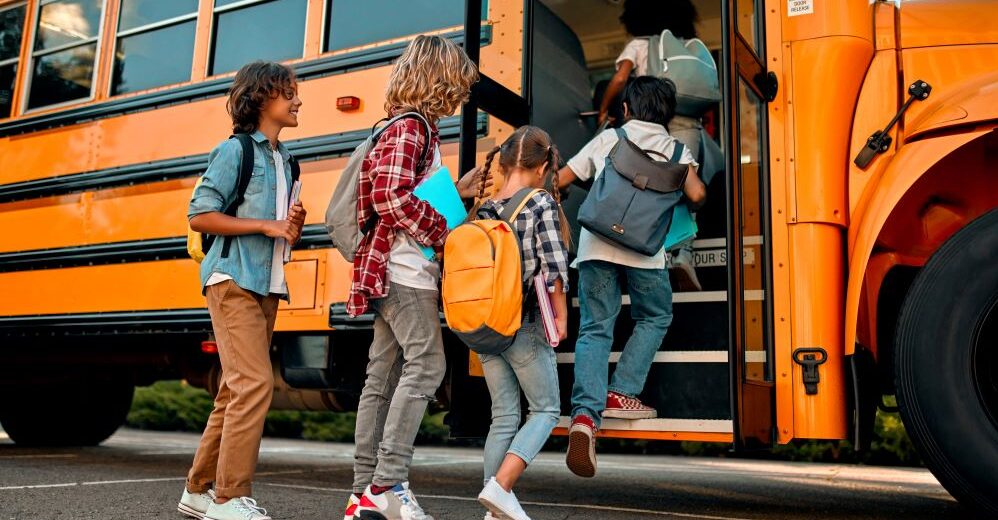As summer winds down and families prepare for another school year, excitement fills the air. New backpacks, fresh school supplies, and the promise of learning adventures ahead create a buzz of anticipation. But alongside this excitement comes a responsibility we all share: keeping our children safe as they return to the classroom.
Although Campus Safety’s primary focus is on keeping kids safe while they are on campus, getting to and from school are also critical windows of vulnerability that must be addressed.
In this guide, we’ll explore essential back-to-school transportation safety strategies. These practical tips will help you create a safety-first mindset that protects your child while allowing them to thrive.
Transportation Safety: Getting There and Back Safely
School Bus Safety Fundamentals
The yellow school bus remains one of the safest ways for children to travel to and from school, but proper safety habits make all the difference. Teaching your child bus safety begins well before they step foot on that first step.
Start by establishing a consistent routine for bus stops. Arrive at least five minutes early to avoid rushing, which can lead to accidents. AAA recommends choosing a waiting spot that’s at least six feet away from the curb. This “safety zone” prevents children from accidentally stepping into traffic while watching for their bus.
When the bus arrives, remind your child to wait until it comes to a complete stop and the driver opens the door. The most dangerous moments occur when children are boarding or exiting, so reinforce the importance of using handrails and taking their time on the steps.
Related Article: How to Improve School Bus Safety Through Training and Technology
For children who need to cross the street after getting off the bus, the rules are critical. They should walk at least ten feet in front of the bus, make eye contact with the driver, and wait for the driver’s signal before crossing. This simple protocol has prevented countless accidents over the years.
Walking and Biking to School
If your child walks or bikes to school, route planning becomes your first line of defense. Walk or drive the route together during daylight hours, identifying potential hazards like busy intersections, construction zones, locations prone to crime, or areas with poor visibility.
Choose routes that include sidewalks whenever possible. If sidewalks aren’t available, teach your child to walk facing traffic on the left side of the road. This positioning allows them to see oncoming vehicles and react accordingly.
For cyclists, helmet use is non-negotiable. A properly fitted helmet can greatly reduce the risk of serious head injury. Ensure your child understands basic traffic rules: stopping at all intersections, using hand signals, and riding with traffic flow rather than against it.
Related Article: Cities, Counties Increasingly Install Speed Cameras in School Zones
Visibility gear transforms safety levels, especially during early morning or late afternoon hours when natural light is limited. Reflective backpack strips, bright clothing, and flashing bike lights make children visible to drivers from much greater distances.
Children who ride their bikes to school should also use bike paths if they are available.
Car Transportation Best Practices
When driving children to school yourself, consistency in safety habits sets the foundation for lifelong safe practices. Every passenger should be properly restrained with a seat belt before the vehicle moves, and this rule applies regardless of trip length.
For elementary-age children, booster seats often remain necessary until they reach the height requirement for adult seat belts: typically around 4 feet 9 inches tall. The seat belt should lie across the chest and hips, not the neck or stomach area.
Create a “no phone zone” in your vehicle during school drop-off and pickup times. These periods often involve heavy pedestrian traffic, with children and parents crossing streets and walking between parked cars. Your full attention on driving can prevent tragic accidents.
Campus Safety: Navigating the School Environment
Building Awareness and Situational Skills
Teaching children to be aware of their surroundings doesn’t mean making them fearful. It means helping them develop smart habits that enhance their safety. This awareness begins with understanding their school’s layout and emergency procedures.
During back-to-school events, walk through the building with your child. Help them locate important areas like the main office, nurse’s office, and their classroom’s emergency exits. This familiarity reduces anxiety and improves response times during actual emergencies.
Encourage your child to identify trusted adults at school beyond their classroom teacher. The principal, school counselors, librarians, office staff and school safety officers all represent safe points of contact if your child ever feels uncomfortable or needs help.
Conversations about stranger safety require careful balance. Children need to understand safety concepts without developing paralyzing fear of all unfamiliar people.
A Shared Commitment to Safety
Safety education should evolve as children grow and develop. Younger children need concrete, simple rules they can easily remember and follow. Older children can understand more complex safety concepts and take greater responsibility for their own protection.
As the school year begins, safety is a shared responsibility that extends beyond the classroom. By teaching children age-appropriate safety habits and modeling responsible behavior, we empower them to navigate their world with confidence and care.
Whether it’s at the bus stop, on a bike, or walking through the school gates, every small step we take to prioritize safety makes a big difference. Together, we can ensure that the journey to and from school is as enriching and secure as the learning that happens within it.
Here’s to a safe and successful school year!







